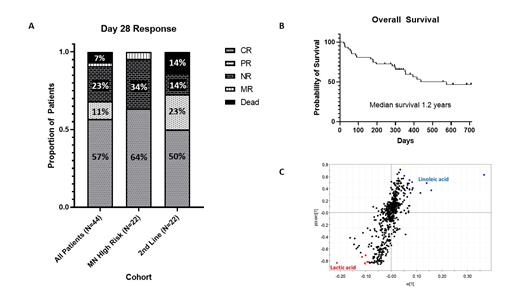Abstract
Background: Severe organ damage from acute graft-versus-host disease (aGVHD) results in a high risk of morbidity and mortality. Treatments that focus on immunosuppression alone do not consistently improve long-term survival. Modalities that aid in inflammation resolution, immune tolerance, and tissue repair may improve outcomes beyond high-dose corticosteroids and other broad immunosuppressants for life-threatening aGVHD. We studied the addition of urinary-derived human chorionic gonadotropin/epidermal growth factor (uhCG/EGF, Pregnyl®, Organon, USA) to standard aGVHD therapy in a prospective Phase 2 clinical trial (NCT02525029) conducted at the University of Minnesota and Rush University, extending from our previously published Phase 1 study results (Holtan et al, Blood Advances, 2020) showing uhCG/EGF to be safe and preliminarily efficacious as aGVHD therapy.
Methods: Patients with new onset Minnesota (MN) high risk aGVHD (N=22) or with aGVHD requiring 2nd line therapy (N=22) received methylprednisolone 48 mg/m2/day plus 2,000 units/m2 of uhCG/EGF subcutaneously (SQ) every other day for 1 week (high risk arm). Patients in need of 2nd line aGVHD therapy received 2,000 - 5,000 units/m2 SQ every other day, with dose depending on organ severity, for 2 weeks plus standard of care immunosuppression (anti-thymocyte globulin (N=4), etanercept (N=1), ruxolitinib (N=5), sirolimus (N=4), steroid boost (N=8)). Patients who achieved a complete or partial response (CR/PR) after their initial course of therapy received twice weekly maintenance doses for the next 5 weeks. Exploratory metabolomic profiling was performed using mass spectrometry.
Results: The median age was 61 years (range 2 years - 72 years, 75% male). The majority of patients had stage 3-4 lower GI GVHD (52%) and overall grade III-IV aGVHD (75%) at time of enrollment, with a median baseline albumin of 2.6 g/dl (range 0.9 - 4 g/dl) and median baseline Karnofsky performance status of 50 (range 20-100). The proportion of patients with a response (CR/PR) at day 28 (primary endpoint) was 68% (57% CR, 11% PR, Figure 1A). Among MN high risk patients receiving 1st line steroids, 64% achieved a CR at day 28 (0% PR). Among patients receiving 2nd line therapy, 50% achieved a CR and 23% PR at day 28. The median overall survival for the entire cohort was 1.2 years (Figure 1B), with a 2-year survival of 67% for responders and 12% for non-responders (p<0.01). Twenty-three died; causes of death included aGVHD (n=9), relapse (n=9), infection (n=3), and organ failure (n=2). Only one dose-limiting toxicity occurred (1 cerebral venous sinus thrombosis, resolved with anticoagulation). Exploratory metabolomic analysis of plasma samples collected during the study suggest potential correlations between blood metabolites and response to therapy. Higher levels of linoleic acid were associated with greater CR/PR rates, while higher levels of lactic acid were associated with treatment failure (Figure 1C).
Conclusion: Our Phase 2 study demonstrates that uhCG/EGF is a promising addition to systemic therapy in patients with life-threatening aGVHD. The overall survival result is encouraging considering historical median survival of <0.5 years for patients with both MN high risk and steroid refractory aGVHD. As a commercially available, safe, and inexpensive drug, addition of uhCG/EGF to standard therapy may reduce morbidity and mortality from severe aGVHD. Further studies to explore its role as a steroid-sparing treatment are warranted.
Holtan: Incyte: Consultancy, Research Funding; Generon: Consultancy. Ustun: novartis: Honoraria; Blueprint: Honoraria. Arora: Pharmacyclics: Research Funding; Syndax: Research Funding; Kadmom: Research Funding. Bachanova: Incyte: Research Funding; FATE: Membership on an entity's Board of Directors or advisory committees, Research Funding; KaryoPharma: Membership on an entity's Board of Directors or advisory committees; Gamida Cell: Membership on an entity's Board of Directors or advisory committees, Research Funding. Betts: Patent Disclosures: Patents & Royalties: B.C.B. holds a patent (WO2015120436A2) related to CD4+ T cell pSTAT3 as a marker and therapeutic target of acute GVHD. B.C.B. additionally holds a provisional patent (WO2017058950A1) related to the use of JAK inhibitors for rejection and GVHD prevention. . Vercellotti: CSL Behring: Research Funding; Mitobridge, an Astellas Company: Consultancy, Research Funding. Brunstein: GamidaCell: Research Funding; NANT: Research Funding; FATE: Research Funding; BlueRock: Research Funding; AlloVir: Consultancy. Janakiram: FATE, Nektar Therapeutics: Research Funding; Bristol Meyer Squibb, Kyowa Kirin, ADCT Therapeutics: Honoraria. Weisdorf: Fate Therapeutics: Research Funding; Incyte: Research Funding. MacMillan: Equilium: Other: DSMB member; Incyte: Consultancy; Jazz Pharmaceuticals: Consultancy.
uhCG/EGF has FDA orphan drug designation to treat acute GVHD.


This feature is available to Subscribers Only
Sign In or Create an Account Close Modal